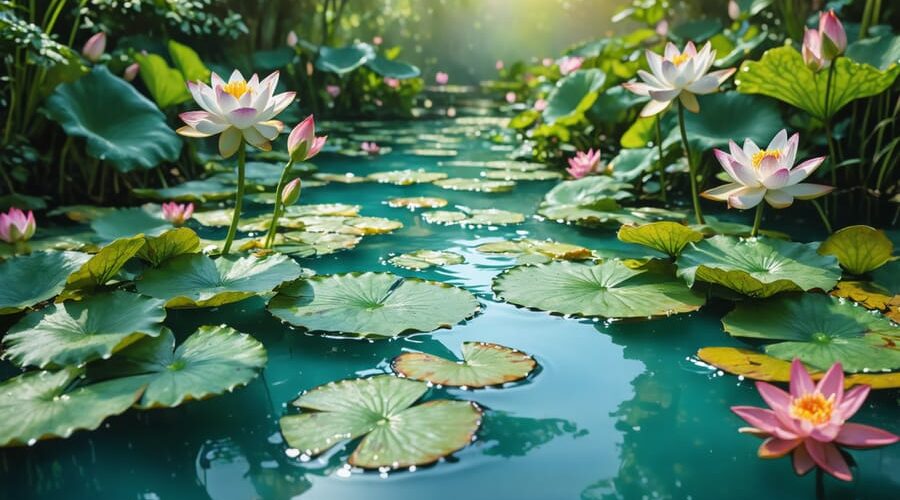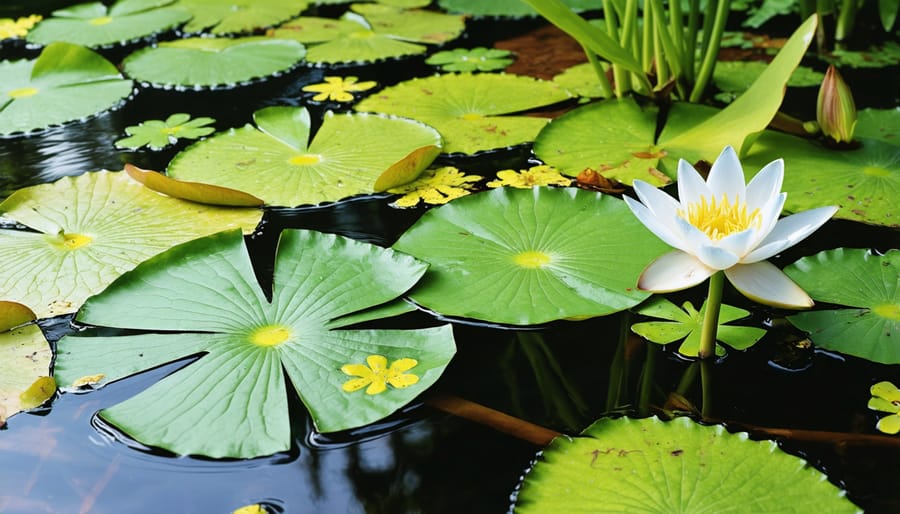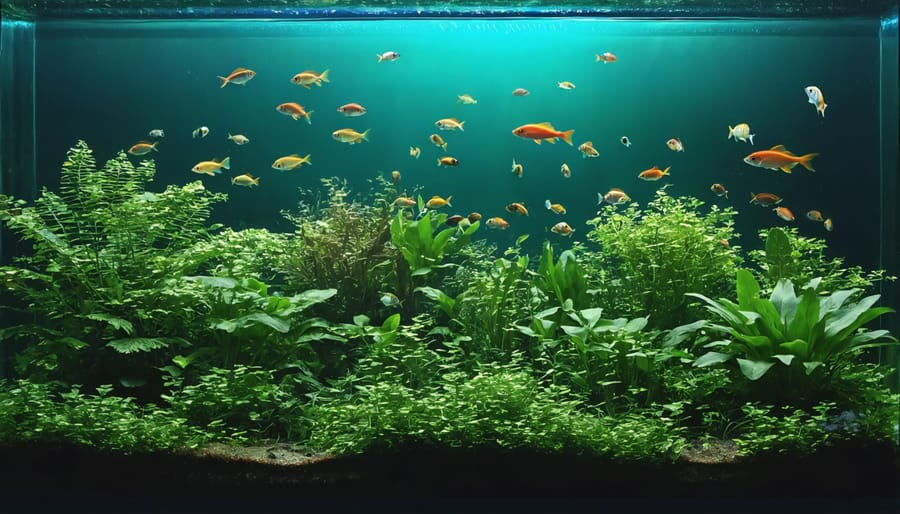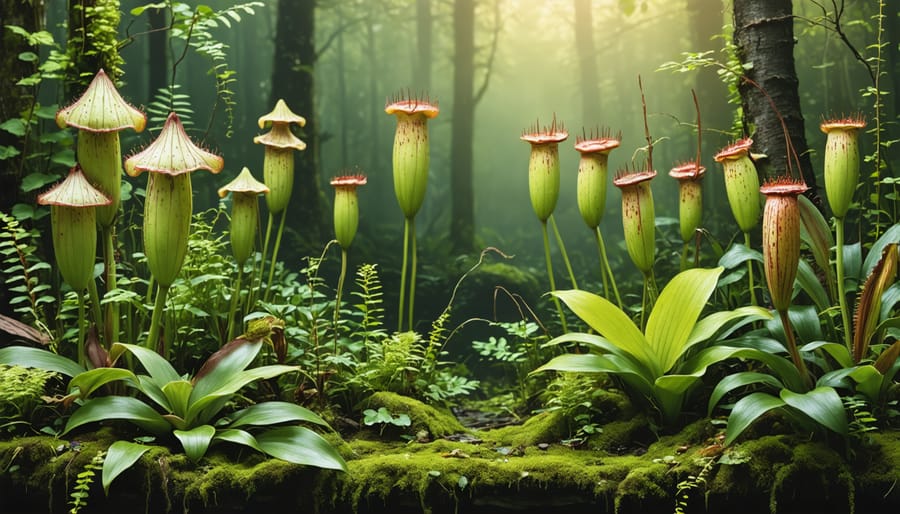
Transform Your Water Garden: Essential Aquatic Plants and Their Growing Secrets
Dive into the fascinating world of aquatic plants, where these remarkable organisms play vital roles in creating a self-sustaining ecosystem in water gardens, ponds, and natural waterways. From floating beauties like water lilies to submerged oxygenators such as hornwort, aquatic plants come in diverse forms that serve unique purposes in water environments. Whether you’re setting up your first pond or expanding your water garden collection, understanding these distinct plant categories helps create thriving aquatic landscapes. Each type – floating, marginal, submerged, and deep-water plants – brings its own benefits, from naturally filtering water and providing shelter for pond life to adding stunning visual appeal throughout the seasons. Let’s explore these fascinating plant groups and discover how to successfully incorporate them into your water feature.

Floating Plants: The Surface Beautifiers
Free-Floating Plants
Free-floating plants add a delightful natural touch to any water feature, drifting gracefully on the surface without needing to be anchored in soil. Duckweed, the smallest flowering plant in the world, creates a vibrant green carpet that fish love to nibble on. While it grows quickly and can cover a pond’s surface in no time, you can easily control it by scooping out excess growth with a net.
Water hyacinth, with its lovely lavender flowers and glossy leaves, is another popular choice. Its thick, spongy stems help it float effortlessly while its hanging roots provide excellent shelter for pond life. These plants multiply rapidly by producing offshoots, making them perfect for filling empty spaces quickly.
Propagating free-floating plants is surprisingly simple. Most reproduce naturally by division – just separate the daughter plants from the mother plant and let them float freely. For water hyacinth, wait until the connected plants have developed their own root systems before gently pulling them apart.
Other notable free-floaters include water lettuce, with its rosette of velvety leaves, and mosquito fern, which turns reddish-purple in bright sunlight. While these plants are beautiful, remember to keep their growth in check, as they can sometimes spread too enthusiastically. Regular maintenance by removing excess growth will keep your water garden looking its best while maintaining healthy oxygen levels for other aquatic life.
Floating-Leaved Plants
Floating-leaved plants add a majestic touch to any water garden, with their elegant leaves resting on the water’s surface and stunning blooms reaching toward the sky. Water lilies and lotus plants are the most popular choices in this category, each offering unique beauty and charm to your pond.
Water lilies come in two main varieties: hardy and tropical. Hardy water lilies are perfect for beginners, as they’re more forgiving and can survive winter in most climates. When it comes to growing water lilies, they need plenty of sunlight and rich, heavy soil in their planting containers. Their leaves provide essential shade for fish and help control algae growth by limiting sunlight penetration.
Lotus plants, while similar in appearance, grow from tubers and prefer slightly different conditions. They need deeper water than water lilies and thrive in containers at least 12 inches deep. The key to successful lotus propagation is starting with healthy tubers and keeping them warm during the growing season. Their leaves can rise several feet above the water surface, creating a dramatic vertical element in your pond.
Both plants spread through rhizomes or tubers and should be divided every few years to maintain healthy growth and prevent overcrowding. Remember to fertilize regularly during the growing season for the best blooming results.
Submerged Plants: The Underwater Warriors

Oxygenating Plants
Oxygenating plants are the unsung heroes of any water garden, playing a crucial role in helping aquatic ecosystems thrive underwater. These remarkable plants work tirelessly to maintain clear pond water by absorbing excess nutrients and releasing oxygen during photosynthesis.
Anacharis, also known as Elodea, is a popular choice for both beginners and experienced water gardeners. This easy-to-grow plant features dense whorls of dark green leaves and can be propagated simply by cutting stems into 6-inch sections and replanting them. Each cutting will develop its own root system within weeks.
Hornwort is another fantastic oxygenator that’s practically impossible to kill. Its feathery, needle-like leaves grow in dense clusters and provide excellent shelter for fish fry. To propagate hornwort, just snip off healthy stems and let them float freely – they’ll naturally sink and establish themselves wherever they settle.
Both plants grow best when anchored in gravel or weighted down initially, though they can also grow as floating plants. For the best results, plant them in bunches of 3-5 stems, spaced about 4 inches apart. Regular trimming helps maintain their shape and promotes bushier growth, while the trimmed pieces can be used to start new plants.
Decorative Underwater Plants
Decorative underwater plants add a mesmerizing touch to any aquatic environment, with species like Cryptocorynes and Java Fern leading the way in popularity. These plants are particularly beloved for their low maintenance needs and stunning appearance.
Cryptocorynes, often called “Crypts” by enthusiasts, come in various colors and leaf patterns. These hardy plants thrive in low to medium light conditions and can adapt to different water parameters. To propagate Cryptocorynes, wait for the plant to develop runners, which will eventually form new plants that can be carefully separated from the mother plant.
Java Fern is another fantastic choice for underwater gardens. Its distinctive dark green leaves grow from a thick rhizome that shouldn’t be buried in substrate – instead, attach it to driftwood or rocks using cotton thread or super glue. Java Fern propagates naturally by producing tiny plantlets on its leaves, which can be left to develop and then gently removed when they have their own roots.
Other attractive options include Anubias, with its thick, leathery leaves, and Amazon Sword plants, which create dramatic focal points. When propagating these decorative plants, patience is key – most underwater species grow relatively slowly but reward you with long-lasting beauty.
For best results, use liquid fertilizers specifically formulated for aquatic plants, and ensure your lighting meets each species’ requirements. Regular pruning helps maintain shape and encourages healthy growth.
Marginal Plants: The Edge Enhancers
Shallow Marginals
Shallow marginal plants add vibrant color and natural beauty to the edges of your pond while providing essential shelter for wildlife. These plants thrive in water depths between 0-6 inches and include popular varieties like iris, rush, and cattails.
The striking Japanese Iris brings spectacular purple blooms in late spring, while Yellow Flag Iris offers golden flowers that attract butterflies. Rush plants, with their tall, slender stems, create elegant vertical interest and work beautifully as backdrop plants. Both species are incredibly easy to grow and maintain, making them perfect for beginners.
To propagate these marginals successfully, start by dividing mature plants in early spring. Simply lift the plant, carefully separate the rhizomes (underground stems) into sections, ensuring each piece has healthy roots and at least one growing point. Plant these divisions in aquatic baskets filled with heavy garden soil, topped with gravel to prevent soil washing away.
For the best results, position your marginals so the crown (where stems meet roots) sits just at or slightly below water level. Most shallow marginals spread naturally over time, but you can control their growth by containing them in baskets. Remember to trim dead foliage in late fall and fertilize sparingly during the growing season for healthy, vibrant plants.
Deep Marginals
Deep marginal plants like cattails and pickerelweed are fantastic additions to any water garden, thriving in depths of 6-12 inches along the pond’s edge. These sturdy plants not only create a natural transition between water and land but also provide essential shelter for wildlife.
Cattails are among the easiest deep marginals to propagate. In spring, you can divide existing plants by gently separating the rhizomes, ensuring each section has healthy roots and at least one growing point. Plant these divisions in heavy clay soil or aquatic planting baskets filled with aquatic compost, positioning them so the crown sits just below the water surface.
Pickerelweed propagation is equally rewarding. These beautiful plants multiply through both root division and self-seeding. The best time to divide pickerelweed is early spring before new growth emerges. Simply lift the entire clump, carefully separate the roots into smaller sections, and replant immediately. Each division should have several healthy shoots and a good root system.
For both plants, remember to use a heavy topsoil layer to prevent floating, and avoid regular garden soil which can cloud your water. Once established, these deep marginals require minimal maintenance – just occasional division every 2-3 years to prevent overcrowding and maintain vigorous growth. Their robust nature makes them perfect for beginners while still being appreciated by experienced water gardeners.
Bog Plants: The Moisture Lovers
True Bog Plants
True bog plants are fascinating creatures that have evolved to thrive in nutrient-poor, acidic environments. Unlike typical aquatic plants, these specialists have developed unique ways to get their nutrients – often by catching and digesting insects! The most famous among them are pitcher plants and sundews, which make stunning additions to any water garden.
Pitcher plants feature distinctive tube-shaped leaves filled with digestive enzymes. They come in various sizes and colors, from the compact Sarracenia purpurea to the towering Sarracenia leucophylla. These carnivorous beauties attract insects with sweet nectar, then trap them in their slippery pitchers.
Sundews (Drosera species) are smaller but equally fascinating. Their leaves are covered in sticky tentacles that glisten like morning dew, hence their name. When an insect lands on these tentacles, they slowly curl around their prey, creating nature’s own flypaper.
Propagating bog plants is surprisingly straightforward. Pitcher plants can be divided in spring when new growth appears – simply separate the rhizomes, ensuring each division has several growing points. Sundews often produce offsets naturally, which can be carefully separated from the parent plant.
For the best results, plant them in a mix of peat moss and sand, keeping the soil consistently moist but not waterlogged. While they love full sun, provide some afternoon shade in hot climates. Don’t fertilize these plants – they’ve evolved to thrive without additional nutrients, and fertilizing can actually harm them.
Remember to use rainwater or distilled water whenever possible, as these plants are sensitive to minerals found in tap water. With proper care, these fascinating carnivores will provide years of entertainment and natural pest control in your water garden.

Marsh Plants
Marsh plants thrive in the transitional zones between land and water, making them perfect for pond edges and boggy areas. These resilient plants add vibrant colors and interesting textures while helping to prevent erosion and providing wildlife habitat.
Marsh marigold (Caltha palustris) is a springtime showstopper with its brilliant yellow blooms. This hardy perennial spreads naturally through self-seeding and root division. For best results, divide marsh marigold clumps in early spring or fall, ensuring each division has healthy roots and at least one growing point. Plant them in consistently moist soil or shallow water up to 4 inches deep.
The cardinal flower (Lobelia cardinalis) stands out with its striking red spikes that attract hummingbirds and butterflies. These plants prefer rich, wet soil and partial shade. Propagate them by collecting seeds in late fall or dividing established clumps in spring. When starting from seed, scatter them on the soil surface as they need light to germinate.
Other popular marsh plants include blue flag iris, which spreads through rhizomes, and swamp milkweed, which grows easily from seed. These plants generally prefer soil that remains consistently damp but not waterlogged. For successful propagation, maintain moisture levels during establishment and protect young plants from strong winds.
Most marsh plants benefit from yearly division to prevent overcrowding and maintain vigorous growth. Add organic matter to the soil before planting, and mulch around established plants to retain moisture and suppress weeds. With proper care, these adaptable plants will create a thriving transition zone in your water garden.
As we’ve explored, aquatic plants offer an incredible variety of options for any water garden or pond. From the striking vertical accents of emergent plants to the delicate floating blooms on the water’s surface, each type brings its own unique beauty and benefits to your aquatic ecosystem. Don’t be afraid to mix and match different categories to create a dynamic and balanced water garden. Start with a few hardy species from each group, and as your confidence grows, experiment with more exotic varieties.
Remember that successful water gardening is all about finding the right balance for your specific environment. Consider your climate, pond depth, and maintenance preferences when selecting plants. Whether you’re drawn to the dramatic lotus flowers, the practical oxygenating plants, or the classic beauty of water lilies, there’s an aquatic plant perfect for your needs.
Begin your water gardening journey with just a few plants, observe how they perform, and gradually expand your collection. With proper care and attention, your aquatic garden will flourish into a stunning display that provides year-round interest and creates a thriving habitat for wildlife.
